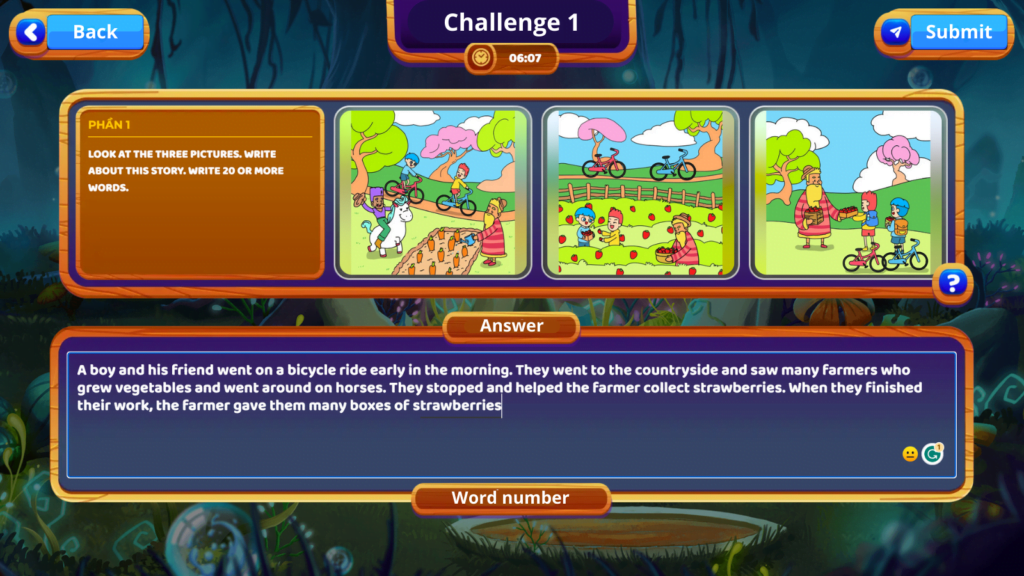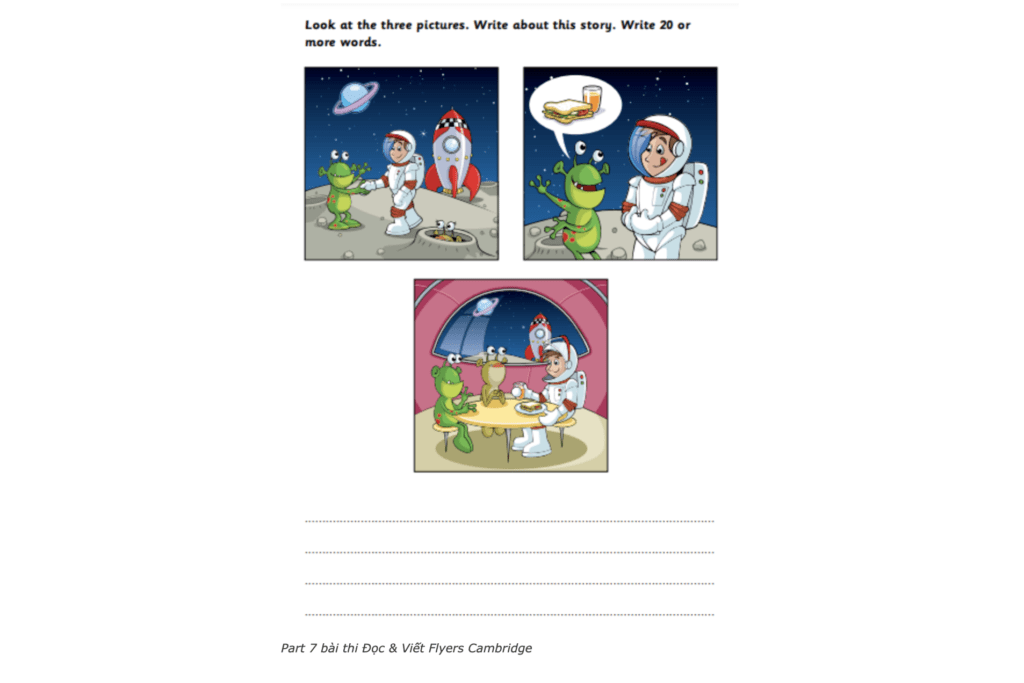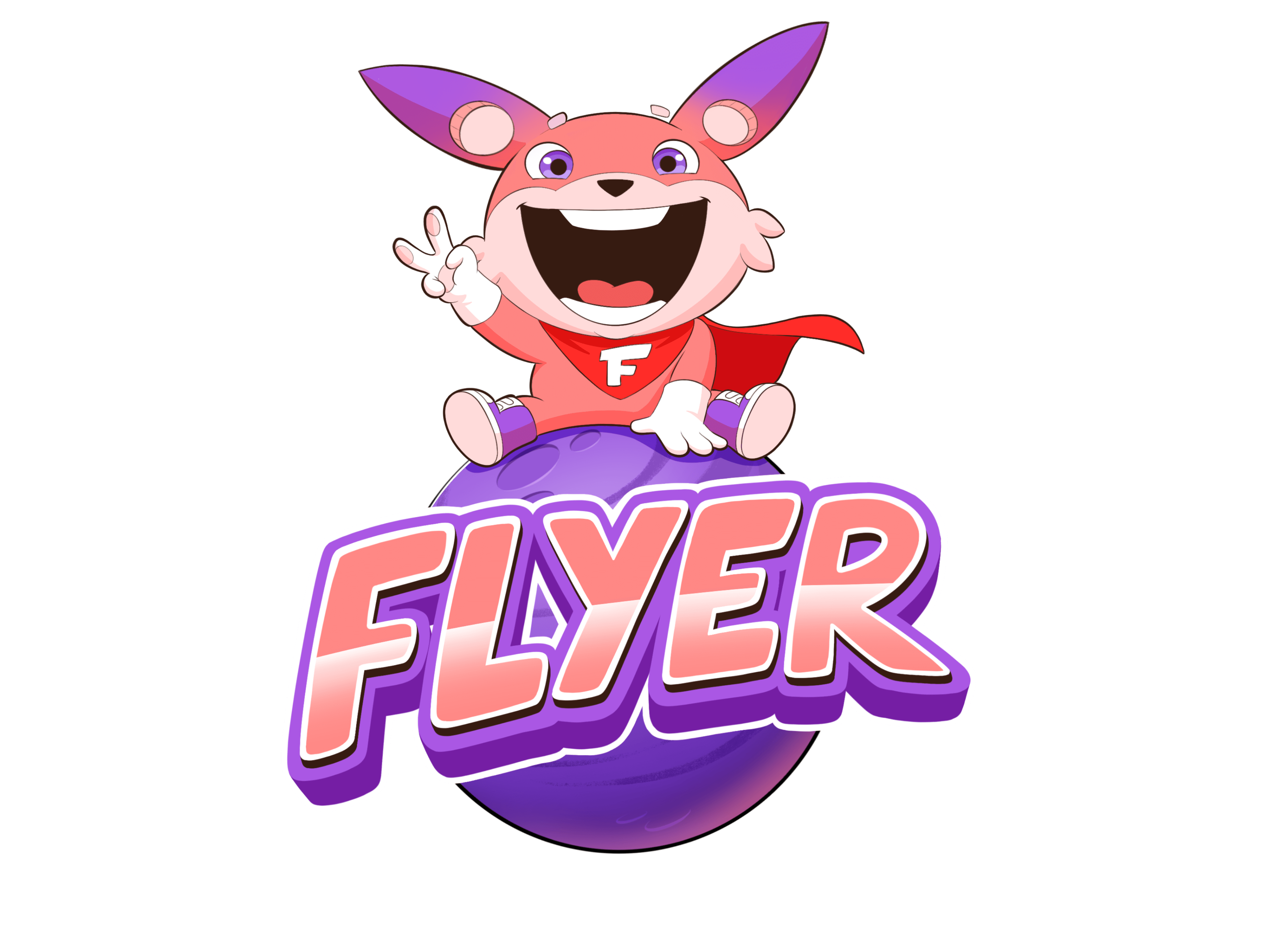In the Cambridge Flyers Reading and Writing test, Part 7 is the most challenging section for candidates. Unlike previous sections where words or sentences are provided for selection, in Part 7, candidates must write a story based on the content of three given pictures. How should candidates write to achieve the highest score? Let’s take a look at the scoring criteria for Part 7 Writing in Cambridge Flyers.
1. An overview of Writing part 7 Cambridge Flyers
The Cambridge Flyers Reading and Writing test consists of 7 sections with increasing levels of difficulty.
| Test part | Test Requirements |
|---|---|
| Part 1 | Read and choose the word that matches the given definition |
| Part 2 | Read and choose the correct sentence |
| Part 3 | Read and choose the correct word |
| Part 4 | Read and choose the correct word |
| Part 5 | Read a passage to find the answer for the word completion exercise |
| Part 6 | Fill in the blanks with words (no words provided) |
| Part 7 – Most Difficult | Examine 3 pictures and write a story based on those 3 pictures |
Writing Part 7 is an open-ended question format, requiring candidates to creatively generate vocabulary and sentence structures to form a logically coherent story that matches the provided pictures.
However, this question format is not entirely open, so candidates are not free to write about any topic of their choice or prepare in advance. They must observe the 3 pictures to understand the artist’s idea, write a passage describing the picture with a minimum of 20 words while ensuring spelling.

2. Writing Part 7 scoring criteria in Cambridge Flyers
The maximum score for Part 7 is 5 points. The detailed scoring criteria are as follows:
| Score | Criteria |
|---|---|
| 5 | – The answer effectively describes the sequence of events in the pictures, ensuring a strong connection. – It describes all 3 pictures. – The content of the story is entirely understandable. |
| 4 | – The answer effectively describes the sequence of events in the pictures, with relatively strong connections. – It describes all 3 pictures. – The content of the story is relatively understandable. |
| 3 | – The answer effectively describes the sequence of events in the pictures, describing at least 1 picture. or – The answer effectively describes the sequence of events in the pictures, describing all 3 pictures, but the content is relatively difficult to understand. The reader may need to read again to understand the story. |
| 2 | The answer contains at least one meaningful phrase. |
| 1 | The answer contains some meaningful words. |
| 0 | No response or the response is entirely incomprehensible. |
3. Sample Answers and Examiner’s Comments
Question

ANSWER 1
One day, there was an astronaut who visited the moon and met an alien. The astronaut was very hungry so he asked the alien for food the alien agreed and he had food with the alien and lived happily ever after.
- Examiner’s Comment:
The candidate described the progression of events and depicted all three pictures provided. The content is relatively easy to understand. The reader can comprehend the story upon the first reading.
- Rating: 5 points
ANSWER 2
Once upon a time in space an astronaut come to the Equestria planet
- Examiner’s Comment:
The candidate managed to write phrases that are easy to understand (once upon a time, astronaut came to the Equestria planet). However, the candidate failed to depict the progression of events in the story, only describing one of the given pictures.
- Rating: 2 points
4. Effective Writing Part 7 tips
- Candidates should write a minimum of 20 words, but they should be cautious not to write excessively. The test provides four lines for writing, and candidates should avoid extending onto the next page because longer writing increases the likelihood of grammatical and spelling errors. Candidates may write more than four lines, but they should always remember that the quality of writing is more important than the quantity of words.
- Before starting to write the essay, candidates should take the time to examine the three provided pictures to understand the story they depict. Each picture should be described in 1-2 sentences. Candidates should also figure out how to connect the pictures to create a coherent narrative.
- When narrating the story, candidates can use simple past tense:
Example: An astronaut arrived on a strange planet. He talked to an alien.
or present continuous tense:
Example: An astronaut is arriving on a strange planet. He is talking to an alien. - Always review the essay to ensure there are no spelling, vocabulary, or grammar mistakes.
5. Cambridge expert shares tips to maximize score in A2 Flyers Writing Part 7
With the most recent format upgrade, the Cambridge Flyers exam has a new kind of activity that calls for students to show more writing proficiency. This is the section that frequently gives students concern since, in past test forms, they were accustomed to finishing sentences, and they found it difficult to comprehend how to compose a paragraph using the given photographs and come up with a good answer.
In this video, the Cambridge expert guide candidates on how to easily achieve the maximum score in the Cambridge Flyers Reading and Writing Part 7:
Step 1: Based on the provided pictures in the task, students list vocabulary related to the images:
- Nouns: kitchen, family, …
- Verbs: cleaning the floor, …
- Adjectives: dirty, …
Step 2: Link the vocabulary and create descriptive sentences for the pictures:
- The family is in the kitchen.
- Jack is cleaning the floor.
Step 3: Add adjectives and adverbs to make the sentences more descriptive:
- The happy family is in the kitchen.
- Jack is slowly cleaning the dirty floor.
By following these steps, students will be able to easily describe the 3 pictures in the task and perform well in Part 7 to achieve the highest score in this test.
6. 200+ Cambridge Flyers practice tests on the virtual testing platform
The FLYER Virtual English Testing Platform offers 200+ A2 Flyers Cambridge exam practice tests (covering all parts: Listening, Reading & Writing, and Speaking) to provide your child with preparation for the Cambridge Starters exam.
- These exams have been carefully compiled to match the format (up to 90%) following Cambridge’s latest standards.
- The automatic scoring system and answer key will help students review and study effectively at home.
- Interactive exercises and game simulations stimulate children’s brain activity and interest in learning.
- It offers various fun learning features such as challenges with friends, short practice exercises, and vocabulary reviews.
Moreover, a helpful feature for parents is the Learning Report, which makes it easy to track the progress of their children’s studies. The system automatically stores all test results and uses them to provide feedback on the student’s current proficiency level, strengths, and areas that require improvement.
More significantly, parents who use FLYER’s virtual testing platform can save up to 80% on their kids’ exam preparation expenses!
Conclusion
It is our goal that this post has helped parents and students understand how to prepare for the Cambridge Flyers Writing Part 7 exam. FLYER hopes that every student has a successful exam season and wishes them luck with their preparations!
Read more



